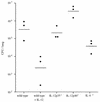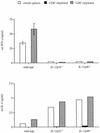Interleukin-12 is essential for a protective Th1 response in mice infected with Cryptococcus neoformans
- PMID: 9746609
- PMCID: PMC108620
- DOI: 10.1128/IAI.66.10.4994-5000.1998
Interleukin-12 is essential for a protective Th1 response in mice infected with Cryptococcus neoformans
Abstract
To analyze the roles of interleukin-12 (IL-12) and the IL-12-dependent Th1 response in resistance to Cryptococcus neoformans, we have established a chronic infection model in wild-type mice and in mice with targeted disruptions of the genes for the IL-12p35 and IL-12p40 subunits (IL-12p35(-/-) and IL-12p40(-/-) mice, respectively) as well as in mice with a targeted disruption of the IL-4 gene. Long-term application of exogenous IL-12 prevented death of infected wild-type mice for the entire period of the experiment (up to 180 days) but did not resolve the infection. Infected IL-12p35(-/-) and IL-12p40(-/-) mice died significantly earlier than infected wild-type mice, whereas infection of IL-4-deficient mice led to prolonged survival. Interestingly, infected IL-12p40(-/-) mice died earlier and developed higher organ burdens than IL-12p35(-/-) mice, which, for the first time in an infection model, suggests a protective role of the IL-12p40 subunit independent of the IL-12 heterodimer. The fungal organ burdens of IL-4-deficient mice and IL-12-treated wild-type mice were significantly reduced compared to those of untreated wild-type mice and IL-12-deficient mice. Histopathological analysis revealed reduction of the number of granulomatous lesions following treatment with IL-12. Susceptibility of both IL-12p35(-/-) and IL-12p40(-/-) mice was associated with marginal production of gamma interferon and elevated levels of IL-4 from CD4(+) T cells, which indicates Th2 polarization in the absence of IL-12, whereas wild-type mice developed a Th1 response. Taken together, our data emphasize the essential role of IL-12 for protective Th1 responses against C. neoformans.
Figures





References
-
- Cherwinski H M, Schumacher J H, Brown K D, Mosmann T R. Two types of mouse helper T cell clone. III. Further differences in lymphokine synthesis between Th1 and Th2 clones revealed by RNA hybridization, functionally monospecific bioassays, and monoclonal antibodies. J Exp Med. 1987;166:1229–1244. - PMC - PubMed
MeSH terms
Substances
LinkOut - more resources
Full Text Sources
Other Literature Sources
Research Materials

